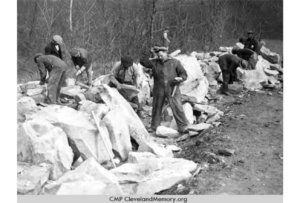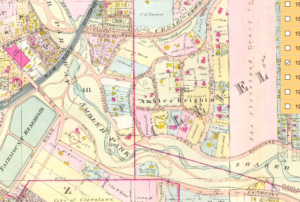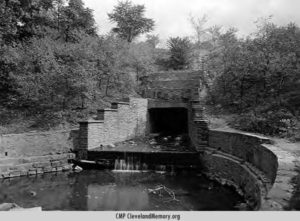


Ambler Park 1934 (CSU), Ambler Park 1912 Map (pub domain), Ambler Park 1940 (CSU)
The Gardeners Versus the Government: The Ambler Park Skirmish
by Marian J. Morton
The pdf is here
Cleveland history buffs love the story of how feisty women’s garden clubs helped halt the federal highway destined to destroy the beautiful Shaker Lakes and nearby neighborhoods. [1] This is what the women did: in 1966, a consortium of 30 garden clubs created what is now the Nature Center at Shaker Lakes and got it designated a national education landmark; so designated, it became it an obstacle to the proposed Clark Freeway. Today, the center’s mission is to preserve and enhance the lakes’ natural environment. It’s a wonderful Goliath versus David story, or rather, a wonderful story of Goliath versus the “ladies in tennis shoes,” as the gardeners were described, the term suggesting that they were ineffectual socialites and dilettantes. The women, of course, had powerful allies: grassroots organizations that sprang up in opposition to the several proposed freeways; the mayors of Shaker and Cleveland Heights and Cleveland Mayor Carl Stokes, who knew very well that freeways can destroy a city; and Sun Press editor Harry Volk, whose editorials and news articles kept the issue alive from 1965 to its demise in 1970.
And whether they knew it or not, the women had history on their side: three decades earlier, the women of local garden clubs had also triumphed over the federal government. Marshalling the power of organized womanhood and their own social connections and with significant help from a sympathetic newspaper, they thwarted the New Deal’s Works Progress Administration (WPA)’s threatened destruction of the natural beauties of Ambler Park.
Beginning in the early twentieth century, garden clubs organized middle- and upper-class women for the socially acceptable purpose of beautifying their own homes and gardens. Club activities – meetings, luncheons, elections, fund-raisers, plant sales, lectures – dominated the women’s pages of many newspapers. And as often happened when women got together, they looked beyond their own homes and became advocates for public causes – in this case, civic beautification and conserving the natural landscape. Consequently, they also became political players.
A local example: in the 1920s, the Shaker Garden Club began to plant wildflowers around the Shaker Lakes and in 1930, cherry trees. In 1933, the club developed a broader plan for the lakes’ region and got permission from the city of Cleveland to “improve park property adjacent to the upper Shaker Lakes.” [2] The lakes had been a gift in 1895 to Cleveland from the Shaker Heights Land Company, which had bought the Shaker community’s property and later sold it to developers Otis P. and Mantis J. Van Sweringen in 1913. The proximity of the lakes to Shaker Heights’ handsome new homes greatly enhanced their value, as the Van Sweringens had hoped.
By 1933, however, the Great Depression had taken hold, and the Van Sweringens’ real estate empire had collapsed. Even affluent suburbs like Shaker and Cleveland Heights had residents so down on their luck that they needed help from the federal government. Franklin D. Roosevelt’s administration created the Civil Works Administration (CWA) to take men off local relief rolls and put them to work on publicly useful projects such as parks, playgrounds, schools, roads, and bridges. Cities that had projects already designed or underway got a head start.
The Shaker Garden Club’s plan for Shaker Lakes, for example, was ready to go. In December 1933, CWA workers, “directed by the City of Cleveland Parks Department … and the women of the Shaker Lakes Garden Club,” began to “transform the 300 acres of forests and meadowlands of Shaker Heights into a great city recreation area.” [3] This ambitious plan didn’t happen exactly that way, but in October 1934, the CWA had almost completed work on the landscaping and a set of stone steps on the peninsula of the upper [Horseshoe] lake. [4]
When the CWA began work on Ambler Park, however, it was a different story: gardeners clashed instead of cooperated with the federal government. The CWA project on Ambler Park was part of the larger project to improve Doan Brook, which began in the Shaker Lakes and then proceeded through Ambler Park and from there to Rockefeller and Gordon Parks. Like the Shaker Lakes, most of Ambler Park had been a gift to the city of Cleveland from a developer, Martha B. Ambler, owner of the property that became Cleveland Heights’ elegant enclave, Ambler Heights, that bordered the park on the north.
Ambler Park also had a very different terrain. The Shaker Lakes were small and man-made, on flat meadowland, and designed to run the mills of the Shaker settlement. The lakes could be easily domesticated with wild flowers and cherry trees. In contrast, much of Ambler Park ran through a steep, shale-lined ravine, which dropped sharply from the lakes on “the heights” down to Cedar Road and University Circle. Major thoroughfares flanked it on the south and north.
The park’s geography did not lend itself to baseball diamonds or tennis courts although there was a small pond at the foot of the park used for ice skating in the 1910s. By necessity and design, most of Ambler Park was kept in its natural state. Cleveland city officials in 1908 hoped to “cultivate [its] wild beauty.” [5] They boasted of its birds and summer foliage. On one sunny Sunday in 1911, 10,000 people rode the streetcar or walked to enjoy the park. [6] The most frequent visitors were the dozens of Boy Scout troops who used the park to test their wilderness skills during the 1920s.
But the untamed landscape also created dangers: children drowned in the pond or ran their sleds into trees; motorists occasionally crashed down into the ravine. And there was crime, including a sensational gangland slaying of two gamblers found trussed up, shot, and tossed into the park’s depths in 1927. And the park itself was endangered. In the mid-1920s, debris from building Baldwin Reservoir to the south was tossed down the ravine. Even worse, in 1930, County Commissioner J.H. Harris suggested that a boulevard be cut through the ravine to speed automobile traffic to and from the Heights. The Cleveland Plain Dealer editorialized about “Saving Ambler Park[:] …. there is no convincing reason why [a roadway] should be made the instrument of destroying most of what remains of Ambler Park’s glory.” [7] The idea went nowhere; Fairhill (then Fairmount) Road on the south side of the ravine was widened instead.
So park lovers were already concerned when the CWA began to enclose Doan Brook with culverts and cement walls in both Rockefeller and Ambler Parks. Photos from April 1934 show workers in Ambler Park struggling with huge chunks of concrete.[8] But the CWA’s primary goal was putting men to work; its secondary goal was to prevent erosion and keep the brook from overflowing its banks. Conserving the beauties of nature was not a priority.
Women’s gardening groups led the attack on what they saw as a destructive approach to the natural landscape. Their spokesperson was Elizabeth Ring Ireland Mather, chairman of the Cleveland parks committee of the Garden Center (now the Cleveland Botanical Gardens). She was the wife of William Gwinn Mather, a prominent industrialist and philanthropist and Cleveland’s “first citizen.” But she was a powerful civic activist in her own right. She was a founder in 1930 of the Garden Center, then located on the Wade Lagoon, and she remained deeply invested in the planning and beautification of University Circle throughout her life. [9]
In 1933, under Mather’s direction, the Garden Center became the Garden Center of Greater Cleveland. Its members included gardening and horticultural groups and women’s civic groups from several suburbs, as well as the Cleveland Museum of Art and the Cleveland Natural History Museum. In December, Mather, on behalf of the center’s “nearly 200,000 members,” asked that federal relief money be spent on planting trees and shrubs along state highways, not simply widening and grading them.[10] Six months later, Mather demanded that Governor George White come up with the money she believed her groups had been promised. [11]
In the meantime, she also accused Cleveland Mayor Harry L. Davis of allowing the managing of Cleveland’s parks to become a “political football”: political appointees who knew little about parks – and were almost certainly Democrats – had allowed streets and parks to become “ugly and neglected.” The city should create a non-partisan park board that would develop a comprehensive plan, informed by experts, she argued. The mayor responded that even if there were enough money for such a board, it would be composed of residents of Cleveland, “not of the Heights.” The message: suburban women had no business poking around in city business. [12] (Mather lived in Bratenahl.)
In 1935, the WPA replaced the CWA. But the approach to Ambler Park remained the same: walls and culverts.
On April 20, 1936, Cleveland Plain Dealer reporter Josephine Robertson blasted the WPA’s destruction of Ambler Park on page one. “Natural beauty spots in the city’s parks are being laid waste by WPA workers …. The pretty meandering brooks and rills in which many generations of children have waded have been organized between high walls like open sewers.” The habitat of woodland animals has been destroyed, she continued, and “The natural mat of leaves and mold, the wild flowers and mosses are being scraped off the banks … The natural cover for birds … is being uprooted.” Robertson interviewed strollers heartbroken and astonished that their park’s natural beauties had fallen victim to “pickaxes and shovels …. ‘The woods is gone now,’” one mourned. [13]
The very next day, Mather and the gardeners jumped in. The Garden Center’s formidable alliance of Cleveland’s social and cultural elite established a committee to “investigate WPA plans to wall up” Doan Brook through Ambler Park. Colonel Joseph H. Alexander, Cuyahoga County WPA director, responded, “It’s all a matter of taste.” The women disagreed. “Why fix nature?” they asked. When he explained that walls would prevent erosion from the thousands of gallons of water dumped into the brook from the reservoir, the gardeners pointed out that this water had been dumped into the brook for many years from the Fairmount and then the Baldwin Reservoir without damage. Further, they accused the WPA of “digging out the homes of little animals and destroying the natural vegetation along the way.” [14]
The Plain Dealer rallied to the women’s cause: “WPA workers, blunderingly trying to improve on nature in Cleveland parks, remind one of those highway engineers who are found occasionally slashing century-old trees so that a road may be made just a big straighter …. Thus many lovers of natural beauty will echo the protest against what the WPA is now doing to Ambler Park. One hopes there is landscaping as well as engineering talent in the high command of the WPA which will stay the hand of the slashers before it is too late.” [15]
In the hot seat, Cleveland City Parks Director Hugh E. Varga passed the buck, claiming that his department had “practically no check on the way projects were carried out,” although the city had apparently okayed the original plans. He promised to do better: “a committee of Cleveland’s most prominent landscape architects [would] recommend” changes to WPA plans. “I will do all I can to preserve the natural beauty of the parks.”[16]
A month later, the Plain Dealer headlines shouted, “Ambler Brook Reprieved; Prison Walls Won’t Rise.” The committee Varga had promised recommended that the eastern end of Ambler Park “should be kept in a natural condition.” The gardeners had won. Robertson breathed a sigh of relief: “the sylvan brook in Ambler Park, which was threatened with being walled up like a sewer … will babble gayly by its natural green and wooded banks.” The chipmunks and the birds are safe, Cleveland children will still wade in the shallow water.” [17]
WPA work on Ambler Park continued through the 1930s. Photographs taken in 1940– at least for public relations purposes – show graceful steps and walkways winding through the stone outcropping and woods that line the brook. [18] The western-most end of Ambler Park was culverted.
Although the WPA left a very visible built legacy in nearby parks – the landscaping and statuary of Rockefeller Park and a handsome bridge in Forest Hills Park – , the WPA left behind in Ambler Park the (almost) natural setting for which the skirmish had been fought.
The preservation of Ambler Park was a small – but early – victory for the environment and for these gardeners: it illustrated that “women in tennis shoes” can be a force to be reckoned with, that private citizens can become political actors, and that private gardens can lead to civic beautification – especially with local journalists on your side. It left a legacy of grassroots activism for women of the 1960s and beyond.
Ambler Park has changed since 1940. Today, Facebook pages show that local artists have left their own marks on its shale outcropping. [19] Mather’s gardeners might not approve. Nevertheless, thanks to her and her gardeners, the park is still a place where strollers and birdwatchers and students can admire and learn about the beauties of nature. [20]
[1] For example, Lauren R. Pacini and Laura M. Peskin, Preserving the Shaker Parklands, The Story of the Nature Center at Shaker Lakes (Cleveland, 2016).
[2] Cleveland Plain Dealer (CPD), June 1, 1933: 4)
[3] Local History Ephemera File, Shaker Heights Library.
[4] CPD, October 14, 1934: 28.
[5] CPD, February 16, 1908: 5.
[6] CPD, October 16, 1911: 12.
[7] CPD, November 18, 1930: 10.
[8] https://clevelandmemory.contentdm.oclc.org/digital/collection/press/id/14388/rec/3
[9] https://case.edu/ech/articles/m/mather-elizabeth-ring-ireland.
[10] CPD, December 5, 1933: 10.
[11] CPD, June 30, 1934: 9.
[12] CPD, May 9, 1934:14.
[13] CPD, April 20, 1936: 1, 5.
[14] CPD, April 21, 1936: 1,4.
[15] CPD, April 21, 1936:8.
[16] CPD, April 24, 1936: 1
[17] CPD, May 25,1936: 1.
[18] https://clevelandmemory.contentdm.oclc.org/digital/collection/gardens/id/258/rec/4; https://clevelandmemory.contentdm.oclc.org/digital/collection/gardens/id/235/rec/7
[19] https://www.facebook.com/photo.php?fbid=1299229313445614&set=a.401484156553472&type=3&theater;
Mr. Adorjan's 6th grade science class learns about geology in the classroom and in the park just south of the school. …
Posted by Roxboro Middle School PTA on Thursday, November 15, 2012
[20] https://www.facebook.com/photo.php?fbid=1299229313445614&set=a.401484156553472&type=3&theater;
